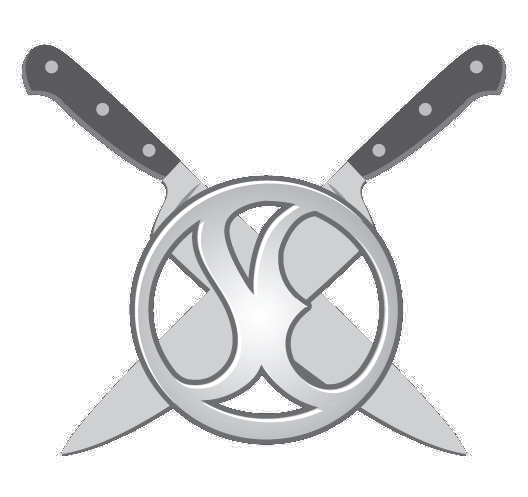MAINTAINING YOUR KNIVES
Keeping your knives sharp and performing well at home is easy. During normal use, a knife edge can "roll over" so the cutting edge no longer "leads." This can cause a knife that still has a sharp edge to cut poorly. To correct and stand the knife edge back up, the two most common methods are honing and stropping.
HONING
Honing "rods" or "steels" are not designed to sharpen knives; they are not significantly harder than the blade and don"t remove metal. Rather, rods and steels are designed to correct the shape of an existing edge, aligning it for maximum cutting efficiency. Avoid using diamond steels/rods as they are harder than blade steel and will remove metal, damaging the fine edge I have put on your knives.
When selecting a rod, pick one long enough for your knives. Most rods come in sizes of 8", 10", and 12". The longer the rod, the more room you have to touch up your knife and the easier the honing. An 8" rod may sound long enough to touch up a 10" chef, but in reality, honing a knife longer than the honing rod can be tricky. A 10" or 12" rod will be a better investment.
CERAMIC RODS
An alternative to a steel honing rod is a ceramic rod. Ceramic rods are highly recommended. Ceramic rods are smooth and will quickly stand an edge up after sharpening. While metal steel may work for German knives, most Asian knives have more delicate blades or thinner edges so a finer honing rod is needed. I use ceramic rods in my kitchen on both my German and Asian knives with fantastic results. Do not drop ceramic rods, as the rods will shatter. In time your ceramic rod will turn grey from accumulated steel residue. A simple way to remove the residue is rubbing a pink eraser along the rod. Wipe the rod off after remove any rubber particles before use.
HONING TECHNIQUE
One of the easiest ways to hone a knife on a rod is to point the rod down on a flat surface, creating a 90 degree angle between the rod and the surface. Brace the rod steady with one hand and slide the knife down the rod at roughly a 15 degree angle, starting at the beginning of the edge closest to the handle and sliding down the rod to the tip. When honing, pretend you are slicing off a strip of the rod. Only the edge should be making contact with the rod as it slides towards the end of the hone. Take your time and move slowly; rushing the honing process will only result in mistakes.
STROPPING
Stropping is similar to honing with more subtle results. If an edge has rolled and is no longer cutting effectively, use a honing rod, then strop after. Stropping also aligns the edge but not as quickly. Once a knife edge has been honed, the newly restored edge has small imperfections and the "micro teeth" along the edge are more aggressive. Stropping will help refine the edge and realign the micro teeth. Stropping after honing will make a sharp edge even sharper for precise, controlled cuts.
If you don't have a leather strop, you don't need to buy one; an old, smooth leather belt will do. Place the belt or strop on a flat surface and put something heavy on one side to anchor and keep the leather from moving while stropping. After you have stabilized your strop, place the knife at the weighted end of the leather. Lift the knife up to match the angle of the bevel and slide BACKWARDS slowly with light pressure. Take your time. After one pass, switch sides and strop the other side of the blade. Repeat this process five or ten times and your edge should be back in peak condition and ready for use. Be careful!
EVENTUALLY...
Over time, the edge on your knife will wear away to the point that honing and stropping will no longer stand the edge back up. At that time, or when the blade has sustained damage, it must be professionally sharpened. There is no standard lifespan of an edge. Some knives will hold their edge longer than others due to blade geometry, steel type, maintenance and use.
Establishing a new edge and fixing damaged knives must be done by a skilled professional to prevent further damage. Blade re-profiling and sharpening is time-consuming and challenging when done well, but the results will increase the lifespan of your cutlery. Seattle Edge is the top-of-the-line knife and tool sharpening with consistently high ratings and customer satisfaction.

